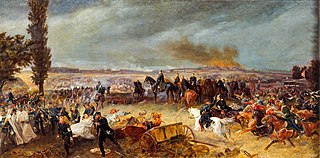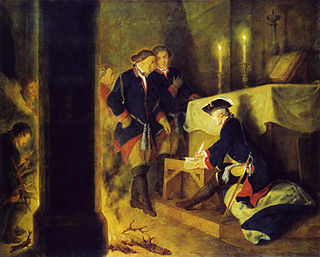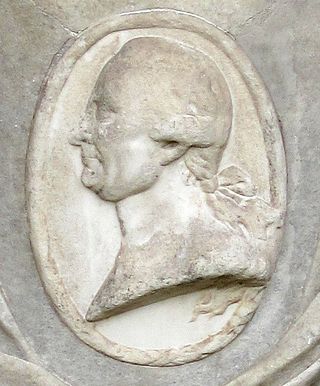
The Battle of Leipzig, also known as the Battle of the Nations, was fought from 16 to 19 October 1813 at Leipzig, Saxony. The Coalition armies of Austria, Prussia, Sweden, and Russia, led by Tsar Alexander I and Karl von Schwarzenberg, decisively defeated the Grande Armée of French Emperor Napoleon Bonaparte. Napoleon's army also contained Polish and Italian troops, as well as Germans from the Confederation of the Rhine. The battle was the culmination of the German Campaign of 1813 and involved 560,000 soldiers, 2,200 artillery pieces, the expenditure of 400,000 rounds of artillery ammunition, and 133,000 casualties, making it the largest battle of the Napoleonic Wars, and the largest battle in Europe prior to World War I.

The Battle of Königgrätz was the decisive battle of the Austro-Prussian War in which the Kingdom of Prussia defeated the Austrian Empire. It took place on 3 July 1866, near the Bohemian city of Hradec Králové and village of Sadová, now in the Czech Republic.

The Silesian Wars were three wars fought in the mid-18th century between Prussia and Habsburg Austria for control of the Central European region of Silesia. The First (1740–1742) and Second (1744–1745) Silesian Wars formed parts of the wider War of the Austrian Succession, in which Prussia was a member of a coalition seeking territorial gain at Austria's expense. The Third Silesian War (1756–1763) was a theatre of the global Seven Years' War, in which Austria in turn led a coalition of powers aiming to seize Prussian territory.

The Battle of Leuthen was fought on 5 December 1757 between Frederick the Great's Prussian Army and an Austrian army commanded by Prince Charles of Lorraine and Count Leopold Joseph von Daun. Frederick used maneuver warfare and knowledge of the terrain to rout the larger Austrian force completely. The victory ensured Prussian control of Silesia during the Third Silesian War, which was part of the Seven Years' War.

The Battle of Zorndorf, during the Seven Years' War, was fought on 25 August 1758 between Russian troops commanded by Count William Fermor and a Prussian army commanded by King Frederick the Great. The battle was tactically inconclusive, with both armies holding their ground and claiming victory. The site of the battle was the Prussian village of Zorndorf. During the battle, Frederick famously took a regimental standard and led an attack himself, rallying his troops.

The Battle of Kunersdorf occurred on 12 August 1759 near Kunersdorf immediately east of Frankfurt an der Oder. Part of the Third Silesian War and the wider Seven Years' War, the battle involved over 100,000 men. An Allied army commanded by Pyotr Saltykov and Ernst Gideon von Laudon that included 41,000 Russians and 18,500 Austrians defeated Frederick the Great's army of 50,900 Prussians.

In the Battle of Torgau on 3 November 1760, King Frederick the Great's Prussian army fought an Austrian army under the command of Field Marshal Leopold Josef Graf Daun. The Prussians won a costly victory in one of the bloodiest battles of the Third Silesian War.

The Battle of Mollwitz was fought by Prussia and Austria on 10 April 1741, during the First Silesian War. It was the first battle of the new Prussian King Frederick II, in which both sides made numerous military blunders and King Frederick II of Prussia fled the battlefield, but the Prussian Army still managed to attain victory. This battle cemented Frederick's authority over the newly conquered territory of Silesia and gave him valuable military experience.

The Battle of Chotusitz, or Chotusice, sometimes called the Battle of Čáslav, took place on 17 May 1742, in Bohemia, now the Czech Republic; it was part of the 1740 to 1742 First Silesian War, itself a subsidiary of the wider War of the Austrian Succession.

Torgau is a town on the banks of the Elbe in northwestern Saxony, Germany. It is the capital of the district Nordsachsen.

Strehla is a small town in the district of Meißen, Saxony, Germany. It is located on the river Elbe, north of Riesa. This place name means arrow in Sorbian. Strehla includes the following subdivisions:

The Second Silesian War was a war between Prussia and Austria that lasted from 1744 to 1745 and confirmed Prussia's control of the region of Silesia. The war was fought mainly in Silesia, Bohemia, and Upper Saxony and formed one theatre of the wider War of the Austrian Succession. It was the second of three Silesian Wars fought between Frederick the Great's Prussia and Maria Theresa's Austria in the mid-18th century, all three of which ended in Prussian control of Silesia.

The Battle of Kesselsdorf was fought on 15 December 1745, between the Kingdom of Prussia and the combined forces of the Archduchy of Austria and the Electorate of Saxony during the part of the War of the Austrian Succession known as the Second Silesian War. The Prussians were led by Leopold I, Prince of Anhalt-Dessau, while the Austrians and Saxons were led by Field Marshal Rutowsky. The Prussians were victorious over the Royal Saxon Army and the Imperial Army of the Holy Roman Emperor.

Ernst Heinrich August de la Motte Fouqué was a Prussian Lieutenant general and General der Infanterie and a confidant of King Frederick the Great. Fouqué held the title of Freiherr (baron).

The Third Silesian War was a war between Prussia and Austria that lasted from 1756 to 1763 and confirmed Prussia's control of the region of Silesia. The war was fought mainly in Silesia, Bohemia and Upper Saxony and formed one theatre of the Seven Years' War. It was the last of three Silesian Wars fought between Frederick the Great's Prussia and Maria Theresa's Austria in the mid-18th century, all three of which ended in Prussian control of Silesia.

The Raid on Berlin took place in October 1760 during the Third Silesian War when Austrian and Russian forces occupied the Prussian capital of Berlin for several days. After raising money from the city, and with the approach of further Prussian reinforcements, the occupiers withdrew. There were later allegations that the Russian commander Count Tottleben had received a personal bribe from the Prussians to spare the city, and he was subsequently tried and found guilty of being a spy.

Hans Sigismund von Lestwitz was a Prussian major general of the infantry and was especially honored by Frederick II for his action in the Battle of Torgau. His decisive leadership at Torgau, in which he snatched victory from defeat, was credited at the time and subsequently with saving the Prussian state. Frederick acknowledged his action with the post-war gift of vast estates near Kunersdorf.

Johann Dietrich von Hülsen was a Prussian lieutenant general of the infantry. After a lifelong officer's career in various infantry regiments, he acquired the special respect of Frederick II in the Seven Years' War as general, and was honored by him with the appointment as governor of Berlin. During the war, he became a canon to Minden and was awarded the Black Eagle Order and the Order Pour le Mérite. His name appears on the top tier of the Equestrian statue of Frederick the Great.

Friedrich Wilhelm Gottfried Arnd von Kleist, was a royal Prussian officer, who rose to the rank of major general. In the Seven Years' War, he organized and commanded the Freikorps Kleist. He was also known as Green Kleist for his command of the Green Hussar regiment, and to distinguish him from the 58 other members of the Kleist family who served in the war. He received the Order Pour le Mérite and is one of the 25 generals depicted on the Equestrian Statue of Frederick the Great.

Peter Ernst von Pennavaire was the son of a French advocate (attorney) in Toulouse who fled France in about 1685. He served in the Prussian army, achieving the rank of lieutenant general of cavalry and proprietor of the Leib-Carabiniers. He was the recipient of the Black Eagle Order and Pour le Mérite. At age 80, he led his cavalry in a charge at the Battle of Breslau at the Austrian front, and died of complications from injuries he received there.




















